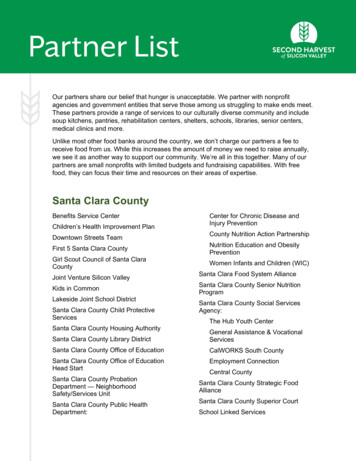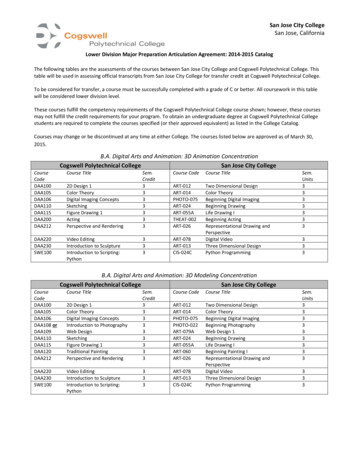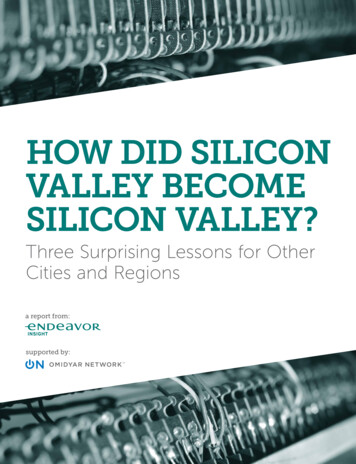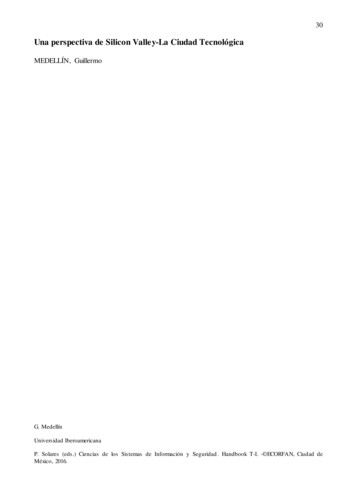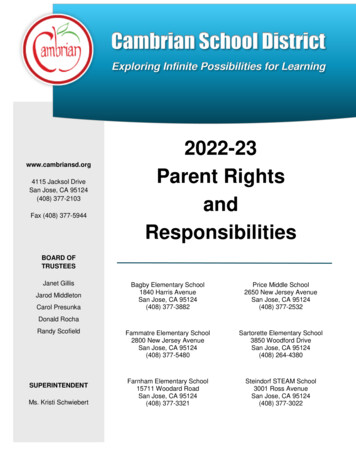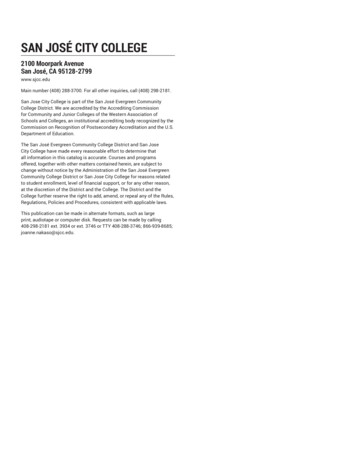
Transcription
Spring 2021at San José StateTransformingSilicon ValleyCollege Celebrates 75 yearsof History and InnovationIngenious DesignStudents Solve PressureIssues for Ventilator ProducerRememberingCharles DavidsonDeveloper, Philanthropist,Affordable Housing ActivistData DetectiveTech ProfessorCollaborates AcrossDisciplines to Save Lives
DE A N’S MESSAG ETA B L E O F C O N T E N T SIn This IssueTHIS SPRING, AS BLOSSOMS BLOOMand leaves unfurl, our society is slowlyre-opening and emerging from theCOVID pandemic.Faculty, lecturers, staff and I are wrestlingwith big questions: what have we learned fromour pivot to mostly online teaching? What isworth keeping as we go forward to both hybridand in-person teaching this fall? How willengineering colleges look different as a resultof this pandemic and its many, multilayeredeffects on our students, families andcommunity? What will the workplace be likefor our graduates and how can we help themto be ready?“ O ur wish isto continuechanging livesfor the better.”We are both sober and grateful to present this celebratory issue marking 75 years asthe College of Engineering at San José State. We have been transforming student livessince 1946, and their success has in turn transformed their families. Furthermore,our alumni have literally and digitally been transforming Silicon Valley into theglobally acknowledged powerhouse it is today.This issue features a timeline with highlights of our history. You can find moreinformation and photos, many of which were contributed by our alumni, on our websiteat https://www.sjsu.edu/engineering75. Please take a look.Our wish is to continue changing lives for the better, whether it be through theDavidson College of Engineering’s memorably empowering professors, by encouragingour students’ networking with professionals at conferences, or by providing richopportunities for our students to conduct research and contribute directly to SiliconValley’s innovation ecosystem.College and Research News6Student-Designed SatellitesAssist Scientists on the Ground7From Flying 20 to PrecisionFlight, and Beyond!Sincerely,Dean Sheryl EhrmanDon Beall Dean of Engineering,Charles W. Davidson College of Engineeringat San José State UniversityEngineering @ San José State Spring 2021Points for Prizes and CareerPreparedness8Better Every Year: The Bay AreaBiomedical Device Conference9Advancing Concrete Knowledgeand Understanding10Students Whistle Up a RapidImprovement to Ventilator Project12Names May Change But theMission Remains Constant13‘General’ BecomesInterdisciplinary Engineering1415Here’s to the next 75 years!245New Master's Specialization inQuantum Computing & InformationAgile Programs for SiliconValley Professionals16Supporting Supply ChainsDuring the Pandemic18Championing EngineeringStudents since 199119SJSU’s Mechatronics ProgramCharles W. Davidson College of Engineering75 YEARS101620How Machine Learning HelpsPrevent Accidents21From Student to BuildingSafety Coordinator232021 National Engineers WeekStudent Video Contest2427Highlights of Our History2830Alumni Notes24A Legacy Perpetuates Engineer’sContribution to His CommunityEvents3
COLLEGE AND RESEARCH NEWSSTUDENT NEWSNSF HONORHiu-Yung Wong, assistant professorof electrical engineering atSan José State University, hasreceived a Faculty Early CareerDevelopment Program (CAREER)award, a prestigious honor bestowedby the National Science Foundation.The award supports his researchof cryogenic electronics—electrical systems that operate atextremely cold temperatures—as well as his project to expandeducation and research opportunities while building a diverseworkforce in the field. Wong will receive about 500,000over five years to implement his project, “Understandingand Modeling of Cryogenic Semiconductor Device Physicsdown to 4.2K MATHEMATICSAND POETRYNEW LABSAND EQUIPMENTKeysight Technologies has generouslygifted the college the KT MechatronicsLab and the KT Radio FrequencyEquipment Station.Students continue togrow with GO programOmron has generously supportedthe College with a new Hornet robot,a gantry-mounted device that can“see” items, reach for them, grab them(with suction or grippers) and movethem to another location. 130The program has quietly been countering what one studentreferred to as “the go HOME program.” Dean Sheryl Ehrmanbegan GO in 2017 when she saw that between studies, jobs, familycare and commuting, students were not particularly aware of ormotivated to grab opportunities that were available to help thembetter prepare for life after graduation.FACULTY GRANTS Anand Ramasubramanian, John Lee, andWendy Lee (Computer Science), "Thrombosis inMicrogravity," NASA, 2020-21 H ongrui Liu, "Proposal to Test/Research MarketClearing Systems For ISO New England," ISO NewEngland, 2021 Vimal Viswanathan, "Collaborative Research:Empowering and Inspiring Confident,Collaborative, and Creative Engineers through anIntelligent Tutoring System," NSF, 2021-24 R on Mak, "Intelligent Systems Research andDevelopment Support-3," NASA P atricia Backer, "Grant Management for PioneerPathways Project," CSU East Bay, 2020-21 HERE ARE FALL 2020’STOP POINT EARNERS,ALL OF WHOMEXCEEDED 100 POINTSAndrea ShteynbergHuman Factors MSTHE DAVIDSON COLLEGE OF ENGINEERING GO Programencourages students to take an active role in preparing for theirengineering career. Current engineering students can earnpoints by participating in career-preparedness activities such asattending non-academic lectures, joining clubs or finessing theirLinkedIn profiles. They cash out their points for prizes, and thereis no limit to how many activities they can undertake.Engineers often get stereotyped as focusing too muchon the technical and not enough on the human aspectof problems. Mechanical Engineering Lecturer, KedarHardikar, breaks that stereotype with the publication ofhis book, Abstract Intersections: A Poetic Journey ThroughMathematics. The publication has earned him five-starreviews from international scholars and laypeople. O zgur Keles, "Scalable Ceramic Alignmentfor Electro-Active Structures," Palo AltoResearch Center, 2020-21Points for Prizes andCareer-PreparednessPrizes like water bottles and t-shirts helped to popularize the GOprogram, but even when campus shut down during the pandemic,students continued to attend Zoom speaker events and participatein other activities that earned them school gift cards, customizedbusiness cards and, for students with more than 100 points, aLinkedIn endorsement from the dean.Jumana NadirSoftware Engr MS150Alexander ShapiroComputer Engineering ‘23155Akansha JajodiaComputer Engr MS280Charlie NinoMechanical Engr ‘23460Dawei WangIndustrial & Systems Engr ‘21A jaw-dropping 1,720 points!Since 2019, Computer Engineering senior project teams have beencreating an app so students can track their own points and evencompete with each other. Interim Computer Engineering ChairRod Fatoohi presented a paper about our seniors building the GOProgram app at the MIPRO 2020 conference. Once the app is fullyfunctioning, the college plans to scale up the program. Errata: Melissa Pardo was an Aerospace Engineering major, not Mechanical Engineering as stated. The Spartan Racing teamwas one of 12 winning teams for the business presentation. It was their first win in business pesentation.4Engineering @ San José State Spring 2021Charles W. Davidson College of Engineering75 YEARS5
F E AT U R EF E AT U R EStudent-Designed SatellitesAssist Scientists on the GroundFrom Flying 20 toPrecision Flight, and Beyond!Initiative empowers four generationsof Aerospace Engineering studentsHistory of San José State’s plucky aviation clubsTHE FLYING 20 WAS ONE OF THE FIRST SJSUEngineering clubs, founded in 1936 by a group of flightenthusiasts, and a number of similar aviation clubsfollowed in its wake. One of these clubs, the SJSUPrecision Flight Team, formed out of a difficult situationfor campus flight programs, and then took its reputationto new heights. Now, this resilient and driven team is usingtechnology to practice together even as the COVID-19pandemic keeps them apart.THE TECHEDSAT IS A JOINT PROJECT OFAerospace students, faculty and alumni at SJSUand NASA Ames. Costing about 50,000 to build,inexpensive by NASA standards, the satellites in thisseries have carried state-of-the-art technologiesthat allow scientists on the ground to processsatellite data more efficiently.In 2013, Aerospace Engineering Professor PeriklisPapadopoulos established an integrated space systemsengineering curriculum, connecting his senior designclasses to real flight deployment and operations.He called the initiative Technology EducationalSatellites, which became the acronym TES.“ We co-authored the safety and systemreqs for such missions with NASA.”“We founded and initiated the TechEdSatseries of flights from its inception at SJSU incollaboration with NASA’s Chief TechnologistOfficer at the time, Dr. John Hines,”said Papadopoulos.This initiative was the first-ever successfuldeployment of a spacecraft from the InternationalSpace Station (ISS) and has been recognizedas such nationally and internationally. Theinitial team established first-of-its-kind spacequalification requirements that meet ISS safetystandards. “We literally co-authored the safetyand system requirements for such missionswith NASA,” said Papadopoulos. To this daythe TES initiative has launched 12 successfulmissions, empowering four generations ofstudent educational experience in space systemsengineering and advancing their post-graduationaerospace careers.6Called CubeSats, the TechEd satellites look likerectangular boxes, roughly 2.5 feet long and weighfifteen pounds. Inside of the boxes are layersof circuit boards that direct electrical charges,allowing the satellite to function. The circuitboards in TechEdSat are made to endure the harshconditions of outer space. In parallel to the TESongoing flights, Dr. Papadopoulos and his SJSU teamhave integrated an astronomical payload to performspectrometric measurements in a small form factorto take advantage of one of the first available flightopportunities of the maiden flights of Blue Origin.The senior design students engaged and successfullydelivered the payload.On the recommendation of the San José CityCouncilmember Raul Peralez, San José MayorSam Liccardo presented a commendation in 2019to the Technology Educational Satellite team fortheir achievements. Engineering @ San José State Spring 2021On a foggy October night in 1960, a chartered planecarrying the Cal Poly Mustang football team crashed ontakeoff in Toledo, Ohio, killing 22 of its passengers. Thistragedy shocked the nation, and led to new regulationsfor the FAA. Once, pilots could use their own discretionto take off in bad weather, and could not be preventedby airport control towers. After the crash, regulationsordered that only air traffic controllers could authorizedepartures. The tragedy also led to some seriousrestrictions for university aviation groups. Even beforeCalifornia Executive Order 82 (1969) prohibited universitystudents from using non-commercial carriers foruniversity-related activities, our San José State flightclubs lost university funding and were forced off campus.and 17th place overall in the 2018 NIFA Nationals.In 2019 they won second place overall in the NIFA RegionalCompetition, held in Prescott, Arizona.The Precision Flight team’s drive to compete hasn’t let upduring a pandemic-- they have been practicing hard overZoom for the last 5 months, with the aim to compete in aregional competition without flying events this year. Theyhope to go on to the Nationals in Oshkosh, Wisconsinin May, once the NIFA makes a decision to host it withmeasures in place for everyone’s safety. Team PresidentBarrett Conelly says of their club’s current unprecedentedchallenge, “Despite the separation, we are still producingthe best minds SJSU Aviation can offer.” The PrecisionFlight team’s website at https://www.sjsupft.com roundsup the club’s social media presence and fundraisingefforts. It also features breathtaking aerial pictures takenby its members, with even more great shots at theirInstagram, @sjsupft. But even with more risk management concerns, insuranceand regulations facing them, the club officers persevered.In 1966, they created the SJSU Precision Flight Team, acompetitive branch of student flight clubs. The successwas immediate, as they won the National IntercollegiateFlying Association (NIFA) competition in 1966, 1968and 1969. In the seventies, they had some of their besttriumphs, notably a 14-trophy, first-overall victory sweep inthe 1974 NIFA Safety Conference regionals.The current Precision Flight students still face the sameregulatory and financial challenges, made more complexby the shifting of aviation instruction sites from the mainSan José Airport to the Reid-Hillview facility. Now thefuture of Reid-Hillview is uncertain. To this day, club fundscome out of student pockets or online donation drives.Despite these limitations, Precision Flight was able to winsecond place in the 2018 regional NIFA Safety Conference,Charles W. Davidson College of Engineering75 YEARS7
F E AT U R EF E AT U R EAdvancing ConcreteKnowledge andUnderstandingBetter Every Year: The Bay AreaBiomedical Device ConferenceStudent-run conference a flagship eventfor the College of EngineeringBy Rebecca Lee (‘22 English)THE BAY AREA BIOMEDICAL DEVICE CONFERENCE(BABMD) is an annual student-run forum forlearning about the latest advances in medical devicetechnologies and regulations, as well as an opportunityto hear from industry professionals, engineers,students and executives. It lets students interact withworld-class researchers from the Bay Area and beyond.Biomedical Engineering (BME) Chair Guna Selvadurayis the SJSU BME Society Advisor, assisting studentswith faculty outreach and connections to theSJSU College of Engineering. BABMD’s theme for2021 is “Technological Responses to Public HealthEmergencies,” highlighting how different sectors of thebiomedical engineering industry, such as healthcare,FDA, business, and research, respond to situations likethe COVID-19 pandemic.This year’s conference in late March was held virtuallyon Gatherly, an online conferencing platform thatallows attendees to network through spatial video chatfeatures. Kevin Wiest, 2021 BME Society president,said, “The conference was split over two days thisyear from 8:00 a.m. - 1:00 p.m. since it would be toomuch for anyone to sit in front of their computer for10 consecutive hours. Given the interactive natureof Gatherly, poster sessions, networking, speakersand sponsors still took place!” Presenters rangedfrom innovators in the medical device industry togovernment experts involved in pandemic response.The BABMD conference has brought in more attendeesfrom across the country each year and successfullycreated a name for itself in the biomedical community.Students organize every aspect of the conference.It’s easy to join even if you don’t have experience: allvolunteers go through training which teaches them8how to converse with the invited speakers, refinetheir resumes, and ultimately, feel more comfortablearound professionals. Students who help organizethe conference walk away with valuable skills such asprofessional networking, collaboration, and projectmanagement. Naenedy Lopez, 2021 BABMD marketinglead, said that she’s also “learned more about differentcareer paths I can take after graduation and about theimportance of networking.”Past volunteers have found jobs and internshipsthrough networking with sponsors and industryspeakers. Student involvement continues aftergraduation, as alumni can get involved as industrypartners, professional attendees and advisors tostudent organizers. Alumni said they’d like to seecontinued success and expanding programs infuture years. Master’s alumnus, Anesh Tilwani, saidhe’d like to see the conference attract “maybe eveninternational registrants someday.” Wiest said he“would like to see speakers and sponsors bring moreof their medical devices with them.” They are greatconversation starters for students new to networking.Amanda Abiera, a BME alumna and consistentattendee, said, “The Bay Area Biomedical DeviceConference holds a special place in my heart. Iliterally made my decision to attend San José Statefor Biomedical Engineering based on my experienceat that first conference. I have attended every singleconference for the last 10 years and love seeing theprogress made each year with increased engagementand attendance from industry leaders and studentsfrom other colleges. The conference is a flagshipevent for the College of Engineering, and I hope tocontinue seeing this event bring the medical devicecommunity together.” Engineering @ San José State Spring 2021Student chapter recognized asExcellent for 5 yearsBy Professor Akthem Al-Manaseer, ACI Faculty AdvisorSAN JOSÉ STATE’S AMERICANConcrete Institute (ACI) StudentChapter of the Departmentof Civil and EnvironmentalEngineering (CEE) has beenrecognized for more thanfive years as an Excellentor Outstanding club by thenational ACI Organization.This prestigious recognitionis awarded only to a selectnumber of universities for theirextraordinary activity andparticipation in ACI events.with a presentation and avideo about the green futureof the concrete industry.The club also organizes educationalLunch and Learn sessions formembers, with the invaluabletime contribution of industrymembers of the local ACI NorthernCalifornia and Western Nevadachapters. These sessions wereparticularly popular during 2020,when students attended virtualpresentations from organizationssuch as Master Builders,Concrete Reinforcing SteelInstitute, National Ready MixedConcrete Association, CentralConcrete, FiberForce and UteliteLW Aggregates.The ACI club offers a numberof social opportunities wherestudents relax and form lifelongfriendships. The ACI club alsooffers business events that givestudents an opportunity tonetwork with industry leaders.Find out more at: https://www.acisjsuchapter.com/ Members successfullyrepresented San José Statein numerous internationalcompetitions organized byACI, which gave students theopportunity to learn about andexperiment with techniques andtechnologies related to concrete.Deliverables included a fiberreinforced concrete bowling balland beam: a new mix design toshowcase mortar workability.This year’s competition team,led by CEE student Zhixian Chen(‘22), will participate virtuallyCharles W. Davidson College of Engineering75 YEARS9
F E AT U R Eand if the pressure isn’t turned down then thepatients’ lungs can be hyperinflated, damagingthem. According to Dr. Fergenson, the San JoséState team came up with an ingenious design towarn when a patient’s lungs were in danger ofbeing hyperinflated, allowing a clinician to lowerthe pressure.They made an alarm that sounds at least64 decibels to warn doctors and nurses if theoxygen level for the patient is incorrect. For this,the students 3D printed a whistle to attach to thedesign and a battery-powered magnetic sensoralarm, providing clinics with choice andbackup options.Students Whistle Up a RapidImprovement to Ventilator ProjectDelivering TLC to COVID-“stiff” lungswith Livermore InstrumentsDURING THE START OF THE COVID-19 PANDEMIC,many places suffered from a shortage of ventilatorsincluding towns in the United States. There are alsoareas around the world with little or no electricitywhere patients are helpless, lacking electricitybased medical devices. An analog ventilator,powered only by a compressed oxygen tank, can bemade at an affordable price and is accessible to awide range of people.Students from the Materials Engineeringdepartment have been working hard on an industrysponsored ventilator improvement project sinceAugust 2020, when Dean Sheryl Ehrman introducedthem to Dr. David Fergenson, president of LivermoreInstruments, whose website tagline is, “Bringing a 700 ventilator to the world at 10,000 units/week.”The Retro Vent 19 consortium had succeeded inreproducing a version of the Bird MARK 7 medical10For the bellows portion of the design, the MaterialsEngineering students had to ensure they would notleak, and they would be durable. Chen said, “Wealso have to make sure that the bellows will resetcorrectly after each breathing cycle. For this part, wewill be using a two-way release valve that can holdthe air as the bellows are being filled and releasethe air on command. A CAD design has already beenmade for the bellows design and we are currentlyworking on finalizing the design and choosing thecorrect materials so our bellows can be 3D printed.”“Some aspects of the design were truly ingenious”,said Dr. Fergenson. “For example, the Retro Vent 19has a particularly high tolerance part with aknown manufacturing failure rate. The studentsreused the “failed” parts in their design, producinga critical and expensive part for literally no cost bydiverting failed parts which would otherwise end upin a landfill.”Dr. Fergenson added, “It’s worth noting that thissame task had previously been assigned to twoother professional mechanical engineers. Of thethree efforts, the San José State team producedthe only realistically workable solution to thisproblem.” You rock, Spartan Engineers!Find more information at https://www.retrovent19.com. VENTILATOR ALARMMechanical Engineering Assistant ProfessorSaeid Bashash and graduate student Tyler Moudy(‘21) are also working on an adjacent visual alarmproject for ventilators: if the air volume is in thenormal range, LEDs will shine green. However,when the volume drops below or goes above acertain level, the LEDs will turn blue or red.ventilator (introduced in 1958) that was amenableto injection molding or mass 3D printing. TheMARK 7 was the world’s first mass-manufacturedmedical ventilator and because it was the first,it lacked some critical safety and performancefeatures which, necessarily, could only bediscovered once medical ventilation was possible.For this project, materials engineering studentsAn Trong (‘21), Scott Lienhart (‘21) and Kyna Chen(MS ‘24), took responsibility for improving thepressure alarm indicator and the bellows portion ofthe ventilator.Patients requiring ventilation due to COVID-19have stiff lungs. The technical term for this is thatthe lungs are “non-compliant.” So higher oxygenpressures are needed to inflate those patients’lungs. But as patients recover their lung healthand capacity, the lungs become more compliantEngineering @ San José State Spring 2021Charles W. Davidson College of Engineering75 YEARS11
F E AT U R EF E AT U R ENames May Change But theMission Remains Constant‘General’ BecomesInterdisciplinary EngineeringThe evolution of the Computer Engineering departmentAs desired job skills change, so do departmentsBy Dr. Rod Fatoohi, and Dr. Haluk OzemekCOMPUTER ENGINEERING HAS AN INTRIGUINGhistory at SJSU, according to Professor Haluk Ozemek,who has been with the program since its inception in1970. That year, the General Engineering departmentbegan to offer a Bachelor’s degree (BS) with a major inGeneral Engineering (Computer Science option).Surrounded by a rapidly evolving Silicon Valleytech industry, students needed to stay current inthe marketplace. In 1976 the General Engineeringdepartment changed its degree offering to BS inEngineering with an option in Computer Science.The department then changed its name in 1982to Computer Science Engineering & GeneralEngineering, and still offered a BS degree inEngineering with an option in Computer Science.According to their ABET report, they were firstawarded accreditation in 1983, an importantmilestone because this new degree was respondingto the needs of the growing Silicon Valley. In 1986, theBS degree in Computer Engineering was first offeredwithin the Computer Science Engineering & GeneralEngineering department.Computer Engineering became its own departmentin 1992. In 1996, several programs including ComputerEngineering merged into a new department called:Computer, Information, and Systems Engineering(CISE). But the Valley kept evolving, as did the needs ofthe students. In 2000 CISE was dissolved, and in 2001the Computer Engineering department restarted. It hasmaintained its name to this day (so far). Providing itsfaculty and students with ample opportunities for closecollaborative ties with industry and research partnersin Silicon Valley, the department serves more than2,200 undergraduate and graduate students. CHAIRS IN HISTORY1976Ed Dionne was the Chair of General Engineering with the Computer Science option.1982 - 1986Elden Shaw (Computer Science Engineering & General Engineering)1986 - 1988Interim Chair Bud Lima (Computer Science Engineering & General Engineering)1988 - 1993Nicholas Pappas (Computer Science Engineering & General Engineering / Computer Engineering)1993 - 1994Interim Chair Jim Freeman (Computer Engineering)1994 - 1996Haluk Ozemek (Computer Engineering)1996 - 1997Gene Moriarty (Computer, Information, and Systems Engineering)1997 - 1999Ben Knapp (Computer, Information, and Systems Engineering)1999 - 2000Lou Freund (Computer, Information, and Systems Engineering)2000 - 2001Haluk Ozemek (Computer Engineering)2002 – 2014Sigurd Meldal (Computer Engineering)2014 – 2020Xiao Su (Computer Engineering)Ping Hsu, arrived at San José State in 1990, thedepartment was already named General Engineering— and it has not changed until now. “Industryopportunities are reflecting a more broadly basedengineering need in addition to traditional, specificengineering skills,” said Hsu. Terms such asInterdisciplinary Engineering, Integrated Engineeringor Multidisciplinary Engineering can be found on all themajor recruiting platforms to address the nature of thelisted job requirements.Beginning in Fall 2021, College of Engineering studentsmay earn a Bachelor of Science Degree in InterdisciplinaryEngineering (IDE). The program, a revision of GeneralEngineering, offers students an opportunity forinterdisciplinary engineering education which has not beenavailable through traditional, single discipline programs.Students have the ability, working with an advisor,to create their own customized pathway of coursesbased on their engineering-related career interest.The revised program provides a structured curriculumto guide students through a broad-based engineeringeducation experience based on an area of focus.Students may also take courses outside of the Collegeof Engineering in support of their educational goalsthat best suit their needs.Many major university engineering colleges acrossthe country offer a similar curriculum structure andprogram name. However, Hsu said, the reason forthe name change at San José State is that it moreaccurately reflects the skills and knowledge astudent can obtain by successful completion ofthe curriculum. “IDE students take the same basicmathematics, physics and other science coursesrequired by other engineering majors, but then theyhave options to select in-depth and broad-relatedareas related to their interest for upper divisioncourses,” said Hsu.An example of the students IDE might best servecould be found in alumnus Vignesh Ramachandran.As an attorney in the intellectual property (IP)practice, he applies his academic and professionaltraining in electrical engineering to his work inpatent prosecution. While a student at San JoséState, Ramachandran was an active member in IEEEand Engineers Without Borders. He continues to beinvolved in the university as a patent review boardmember of the Research Foundation and anAdvisory Council member. As council member,working closely with IDE Chair Hsu, he is developingan IP program within the Interdisciplinary Engineeringcurriculum and hoping that more engineers willconsider a career in IP. “IDE students take the same basic mathematics, physics andother science courses required by other engineering majors,but then they have options to select in-depth and broad-relatedareas related to their interest for upper division courses.”—Ping Hsu, General Engineering Chair at San José State2020 – Present Interim Chair Rod Fatoohi (Computer Engineering)12WHEN GENERAL ENGINEERING CHAIR,Engineering @ San José State Spring 2021Charles W. Davidson College of Engineering75 YEARS13
F E AT U R EF E AT U R ENew Master’s Specialization inQuantum Computing & InformationCreating a diverse taskforce with quantumcomputing know-howBy Hiu Yung Wong, assistant professor, Electrical Engineeringintegrated circuits that are used to manipulateand control quantum computers at cryogenictemperature (4.2K). Through recentlyawarded NSF funding, students will alsogain hands-on experience in cryogenicelectrical measurements.FOR DECADES, NON-PHD MINORITY SERVINGInstitutes (MSIs) have been steadily providing adiverse workforce to the semiconductor industry,which sustains the United States semiconductorindustry’s ecosystem and its competitiveness.For example, Silicon Valley companies such asApple and Cisco hire the largest number of alumnifrom San José State as test engineers, circuit andlayout designers, device engineers, programmers,marketing and program managers, businessanalysts and lawyers.This hiring is also a result of the close collaborationbetween San José State and industry aroundinternship and certificate programs. Our collegeis convinced that for the American quantumcomputing and information industry and ecosystemto be successful and competitive, a diversetaskforce with quantum computing know-how fromMSIs is not just crucial but essential.The Electrical Engineering (EE) departmentrecently created a specialization in QuantumComputing and Information for its Master’s degreeprogram. As initially planned, this specializationcomprises three classes:141.Introduction of Quantum Computing (EE225),first offered in spring 2020 by leveraging theQuantum Classroom, a collaboration betweenSan José State and IBM. Students learnquantum computing algorithms and verify t
Assist Scientists on the Ground 7 From Flying 20 to Precision Flight, and Beyond! . (NIFA) competition in 1966, 1968 and 1969. In the seventies, they had some of their best triumphs, notably a 14-trophy, first-overall victory sweep in the 1974 NIFA Safety Conference regionals. The current Precision Flight students still face the same
